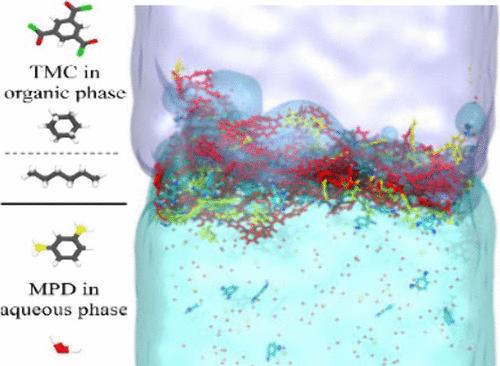当前位置:
X-MOL 学术
›
ACS Appl. Mater. Interfaces
›
论文详情
Our official English website, www.x-mol.net, welcomes your
feedback! (Note: you will need to create a separate account there.)
Interfacial Polymerization of Aromatic Polyamide Reverse Osmosis Membranes
ACS Applied Materials & Interfaces ( IF 8.3 ) Pub Date : 2024-11-18 , DOI: 10.1021/acsami.4c16229 Size Zheng, Jacob Gissinger, Benjamin S. Hsiao, Tao Wei
ACS Applied Materials & Interfaces ( IF 8.3 ) Pub Date : 2024-11-18 , DOI: 10.1021/acsami.4c16229 Size Zheng, Jacob Gissinger, Benjamin S. Hsiao, Tao Wei

|
Polyamide membranes are widely used in reverse osmosis (RO) water treatment, yet the mechanism of interfacial polymerization during membrane formation is not fully understood. In this work, we perform atomistic molecular dynamics simulations to explore the cross-linking of trimesoyl chloride (TMC) and m-phenylenediamine (MPD) monomers at the aqueous–organic interface. Our studies show that the solution interface provides a function of “concentration and dispersion” of monomers for cross-linking. The process starts with rapid cross-linking, followed by slower kinetics. Initially, amphiphilic MPD monomers diffuse in water and accumulate at the solution interface to interact with TMC monomers from the organic phase. As cross-linking progresses, a precross-linked thin film forms, reducing monomer diffusion and reaction rates. However, the structural flexibility of the amphiphilic film, influenced by interfacial fluctuations and mixed interactions with water and the organic solvent at the solution interface, promotes further cross-linking. The solubility of MPD and TMC monomers in different organic solvents (cyclohexane versus n-hexane) affects the cross-linking rate and surface homogeneity, leading to slight variations in the structure and size distribution of subnanopores. Our study of the interfacial polymerization process in explicit solvents is essential for understanding membrane formation in various solvents, which will be crucial for optimal polyamide membrane design.
中文翻译:

芳香族聚酰胺反渗透膜的界面聚合
聚酰胺膜广泛用于反渗透 (RO) 水处理,但膜形成过程中界面聚合的机理尚不完全清楚。在这项工作中,我们进行了原子分子动力学模拟,以探索三甲酰氯 (TMC) 和间苯二胺 (MPD) 单体在水-有机界面上的交联。我们的研究表明,溶液界面为交联提供了单体的“浓缩和分散”功能。该过程从快速交联开始,然后是较慢的动力学。最初,两亲性 MPD 单体在水中扩散并积聚在溶液界面处,与有机相中的 TMC 单体相互作用。随着交联的进行,会形成预交联的薄膜,从而降低单体扩散和反应速率。然而,两亲性薄膜的结构柔韧性受界面波动以及与水和溶液界面处有机溶剂的混合相互作用的影响,促进了进一步的交联。MPD 和 TMC 单体在不同有机溶剂(环己烷与正己烷)中的溶解度会影响交联速率和表面均匀性,导致亚纳米孔的结构和尺寸分布略有变化。我们对显式溶剂中的界面聚合过程的研究对于了解各种溶剂中的膜形成至关重要,这对于优化聚酰胺膜设计至关重要。
更新日期:2024-11-18
中文翻译:

芳香族聚酰胺反渗透膜的界面聚合
聚酰胺膜广泛用于反渗透 (RO) 水处理,但膜形成过程中界面聚合的机理尚不完全清楚。在这项工作中,我们进行了原子分子动力学模拟,以探索三甲酰氯 (TMC) 和间苯二胺 (MPD) 单体在水-有机界面上的交联。我们的研究表明,溶液界面为交联提供了单体的“浓缩和分散”功能。该过程从快速交联开始,然后是较慢的动力学。最初,两亲性 MPD 单体在水中扩散并积聚在溶液界面处,与有机相中的 TMC 单体相互作用。随着交联的进行,会形成预交联的薄膜,从而降低单体扩散和反应速率。然而,两亲性薄膜的结构柔韧性受界面波动以及与水和溶液界面处有机溶剂的混合相互作用的影响,促进了进一步的交联。MPD 和 TMC 单体在不同有机溶剂(环己烷与正己烷)中的溶解度会影响交联速率和表面均匀性,导致亚纳米孔的结构和尺寸分布略有变化。我们对显式溶剂中的界面聚合过程的研究对于了解各种溶剂中的膜形成至关重要,这对于优化聚酰胺膜设计至关重要。

































 京公网安备 11010802027423号
京公网安备 11010802027423号